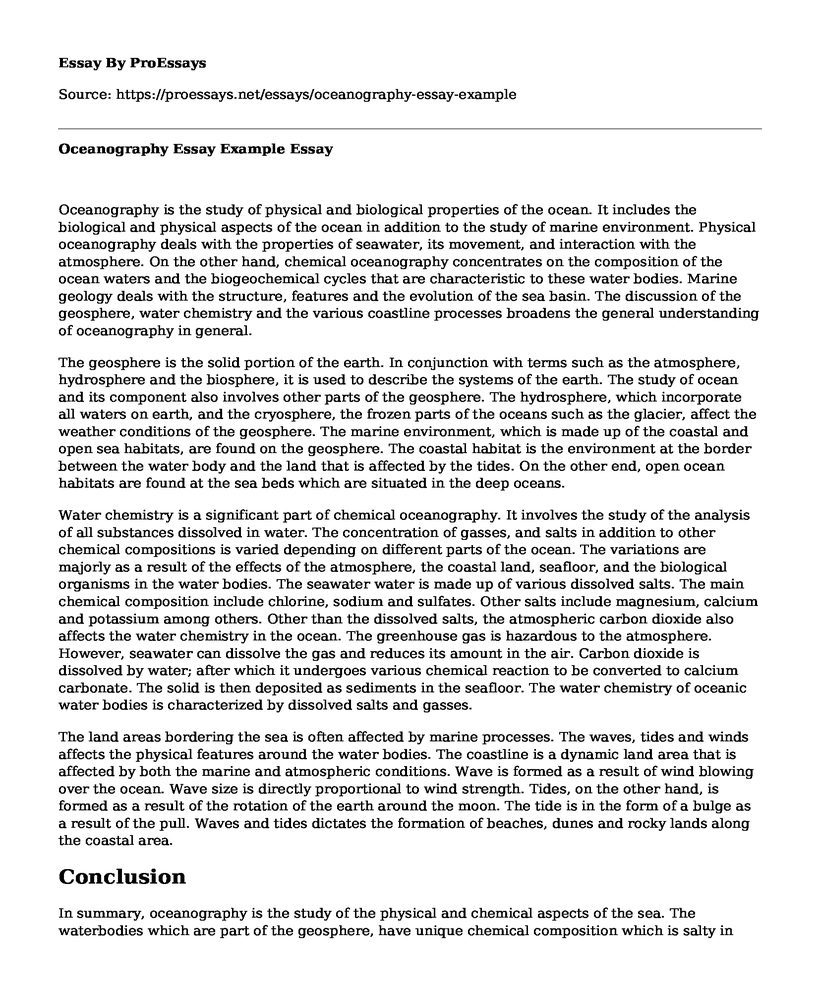Oceanography is the study of physical and biological properties of the ocean. It includes the biological and physical aspects of the ocean in addition to the study of marine environment. Physical oceanography deals with the properties of seawater, its movement, and interaction with the atmosphere. On the other hand, chemical oceanography concentrates on the composition of the ocean waters and the biogeochemical cycles that are characteristic to these water bodies. Marine geology deals with the structure, features and the evolution of the sea basin. The discussion of the geosphere, water chemistry and the various coastline processes broadens the general understanding of oceanography in general.
The geosphere is the solid portion of the earth. In conjunction with terms such as the atmosphere, hydrosphere and the biosphere, it is used to describe the systems of the earth. The study of ocean and its component also involves other parts of the geosphere. The hydrosphere, which incorporate all waters on earth, and the cryosphere, the frozen parts of the oceans such as the glacier, affect the weather conditions of the geosphere. The marine environment, which is made up of the coastal and open sea habitats, are found on the geosphere. The coastal habitat is the environment at the border between the water body and the land that is affected by the tides. On the other end, open ocean habitats are found at the sea beds which are situated in the deep oceans.
Water chemistry is a significant part of chemical oceanography. It involves the study of the analysis of all substances dissolved in water. The concentration of gasses, and salts in addition to other chemical compositions is varied depending on different parts of the ocean. The variations are majorly as a result of the effects of the atmosphere, the coastal land, seafloor, and the biological organisms in the water bodies. The seawater water is made up of various dissolved salts. The main chemical composition include chlorine, sodium and sulfates. Other salts include magnesium, calcium and potassium among others. Other than the dissolved salts, the atmospheric carbon dioxide also affects the water chemistry in the ocean. The greenhouse gas is hazardous to the atmosphere. However, seawater can dissolve the gas and reduces its amount in the air. Carbon dioxide is dissolved by water; after which it undergoes various chemical reaction to be converted to calcium carbonate. The solid is then deposited as sediments in the seafloor. The water chemistry of oceanic water bodies is characterized by dissolved salts and gasses.
The land areas bordering the sea is often affected by marine processes. The waves, tides and winds affects the physical features around the water bodies. The coastline is a dynamic land area that is affected by both the marine and atmospheric conditions. Wave is formed as a result of wind blowing over the ocean. Wave size is directly proportional to wind strength. Tides, on the other hand, is formed as a result of the rotation of the earth around the moon. The tide is in the form of a bulge as a result of the pull. Waves and tides dictates the formation of beaches, dunes and rocky lands along the coastal area.
Conclusion
In summary, oceanography is the study of the physical and chemical aspects of the sea. The waterbodies which are part of the geosphere, have unique chemical composition which is salty in nature. The tides and waves, which are some of the movement of water, affect the physical features of the adjacent land masses.
Cite this page
Oceanography Essay Example. (2022, Jun 05). Retrieved from https://proessays.net/essays/oceanography-essay-example
If you are the original author of this essay and no longer wish to have it published on the ProEssays website, please click below to request its removal:
- Urban Heat Islands
- Electrical Conductivity of the Soil
- Discussion Board Paper Example: Aliens!
- Atomic Nuclear Decay and Uses of Radioactivity in Healthcare Paper Example
- Essay Sample on Golly's Study Foundings
- Essay on the Interconnectedness of Animal Diseases: An Analysis of Quammen's Spillover
- Essay Example on Auditory System: Sensory Organs, Motion Tasks, and Cortex







